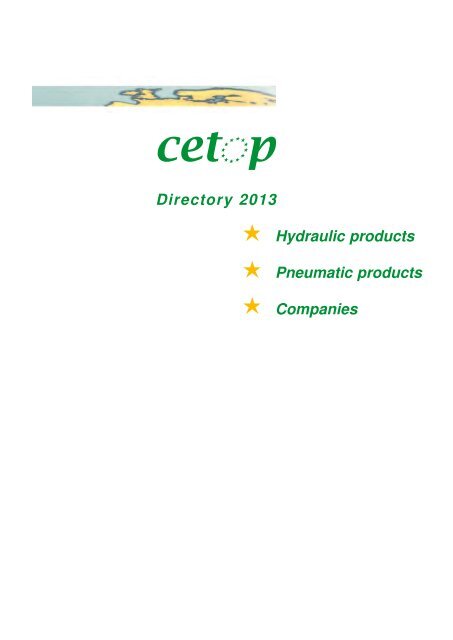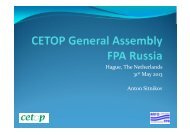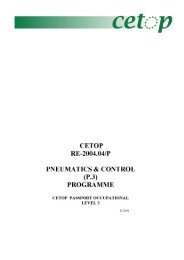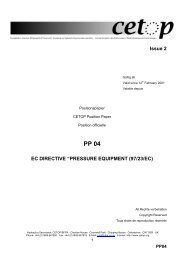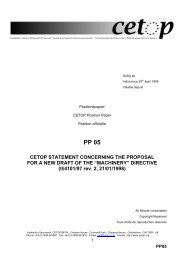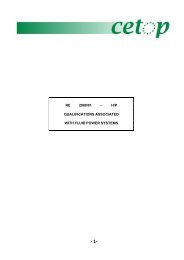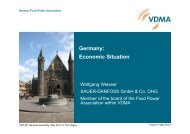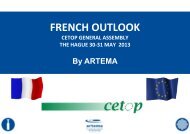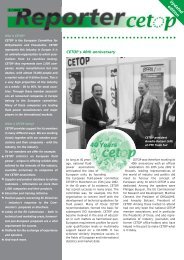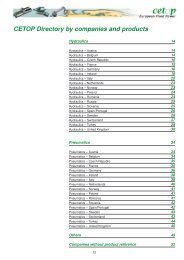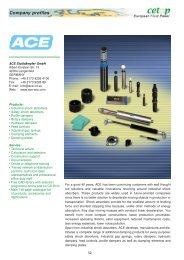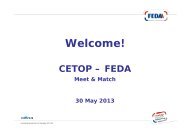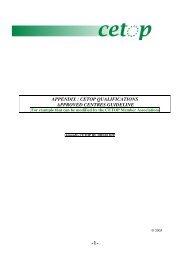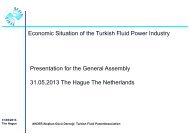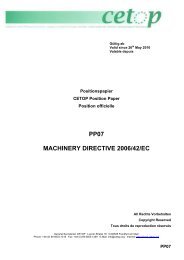CETOP About CETOP
CETOP About CETOP
CETOP About CETOP
You also want an ePaper? Increase the reach of your titles
YUMPU automatically turns print PDFs into web optimized ePapers that Google loves.
Who is <strong>CETOP</strong>?Who is <strong>CETOP</strong>?<strong>CETOP</strong> is the European Committeefor Oilhydraulics and Pneumatics.<strong>CETOP</strong> represents this industry inEurope. More than 50 years ago,national fluid power associationsantic ipated the idea of Europeanunity by founding the European fluidpower committee <strong>CETOP</strong> in Stockholmon 15th June 1962. They thuscreated the basis for co-operationand communication at Europeanlevel based on mutual trust and forthe benefit of the industry as a whole.<strong>CETOP</strong> is an umbrella organisation towhich associations from 17 countriesbelong. <strong>CETOP</strong> thus represents over1,000 companies, mainly manufacturersbut also dealers, with almost70,000 people and a market value of13 billion EURO. This is a very highproportion of the industry as a whole –80 to 90 % for most countries.Through these member associationsall renowned com panies in Europebelong to the European committee.Many of these companies are leadingfluid power manufacturers andmajor players in the internationalmarkets.The voice of the Europeanfluid powerThe purpose of <strong>CETOP</strong> is to speakfor the European fluid power industry.With regard to Northern, Central andSouthern Europe, it has been highlysuccessful in its role as an umbrellaorganisation. Virtually all the relevantEuropean national fluid power associationsare members of <strong>CETOP</strong>. In thecountries of the exten d ed EuropeanUnion and in Eastern Europe, onthe other hand, <strong>CETOP</strong> has someconsiderable potential still to exploit.Some of these countries, such as theCzech Republic, Poland, Romania,Russia and Slovenia, are alreadyrepresented in <strong>CETOP</strong> via theirnational associ ations while <strong>CETOP</strong>is in the process of making an initialcontact with other countries. Theseinclude Bulgaria, Ukraina, Slovakiaand Hungary. <strong>CETOP</strong> also intendsto establish progressive contact withother countries. Undoubtedly, therewill be certain cases where no fluidpower association is in existence, andin these cases <strong>CETOP</strong> shall enterinto discussion with other organisations with a similar character.<strong>CETOP</strong> also has good contacts inother regions of the world and worksin close co-operation and mutualconfidence with the relevant fluidpower associations whenever appropriate.These associations are NFPAin America, JFPA in Japan, CHPSA<strong>CETOP</strong> member associations4
What is <strong>CETOP</strong> doing?The web site also includes informationon technical universities andmagazines which are concerned withfluid power, together with listings ofinternational trade fairs and exhibitionsand the addresses of other fluidpower associations.A special area of the web site is devotedto the <strong>CETOP</strong> EducationInitiative. All the Education Re commendationsrelating to this are availableas downloads. For example,requirement profiles are availablefor various basic and further traininglevels in the fields of mo bile hydraulics,industrial hy drau lics and pneumatics.The website also contains a list of<strong>CETOP</strong> certified Education centres.Exhibitions and trade fairsThe European committee <strong>CETOP</strong>is a vital presence at the majorfluid power exhibitions and tradefairs around the world. For example,<strong>CETOP</strong> participates either as a directexhibitor or a sub-exhibitor in associationwith a member association inthe following events: FluidtransCOMPOMAC (TPA Italia) in Milan,IFPE in Las Vegas, MDA in Hanover,PTC Asia in Shanghai, MDA INDIAin Delhi, Scanautomatic inGöteborg, PNEUMATICON in Kielce,WIN, Istanbul, etc. The aim is to supportthe marketing of the companiesin member associations with the aidof the <strong>CETOP</strong> Directory.Furthermore, <strong>CETOP</strong> awards the titleof “<strong>CETOP</strong> sponsored exhibition” tomajor fluid power exhibitions andfairs. This action, in consultation withthe relevant national member association,emphasizes the importance ofthe event concerned for the industry.To be awarded this title, events mustbe recognised interna tional exhibitionsand fairs which offer a representativeoverview of the industry.Representing technical interests<strong>CETOP</strong> is also active in the field ofthe representation of technical interests,for example in the area ofEuropean Directives and the effect ofthese on the fluid power industry. Withits Technical Com mission, <strong>CETOP</strong>can draw on an excellent network oftechnical experts who discuss thesesubjects whenever necessary fromthe point of view of the fluid powerindustry. They produce statements onthese, or “Position Papers“ as in thecase of European Directives.The Single European Market makesit necessary, among other things,to harmonise national regulations,8directives and standards, with theaim of eliminating restrictions orbar riers to trade. This is achievedthrough European Directives, whichare then enacted as national legislationby each EU member state.Fluid power components and systemsmay fall within the scope of a numberof European Di rec tives, such as theMachinery Directive, the Directive onElectro magnetic Compatibility, thePressure Vessels Directive and theATEX Directive. <strong>CETOP</strong> interpretsthe Directives and their requirementswith regard to their consequences forfluid power components and systems.<strong>CETOP</strong> Position Papers are publishedfor some of the Directives which affectthe fluid power industry.<strong>CETOP</strong> Position Papers<strong>CETOP</strong> has published Position Pa person the following EU Directives:• EC Machinery Directive(06/42/EC)• EC Pressure equipment Directive(97/23/EC)The Position Papers are available asdownload on the <strong>CETOP</strong> web site:www.cetop.org.
<strong>CETOP</strong> Education Strategy<strong>CETOP</strong> Education Strategy 2013 onwardsCompetence based educationand training is at the forefrontof the <strong>CETOP</strong> agenda and with awell established set of “EducationRecommendations” the key wordsfor the future are “networking”,“sharing good practices” and“being involved” and that relatesto every national association whois member of <strong>CETOP</strong>.The “aims and objectives” lay withinthe plan to develop a network ofCentres of Vocational Excellence,approved and qualified to manage,administer and deliver to a commonrecognised standard, <strong>CETOP</strong> competencebased qualifications. Thesecentres will cover a range of occupationallevels relating to the maintenanceand management of mobilehydraulic systems and control, industrialhydraulic and control and powerpneumatics and control.<strong>CETOP</strong> Education missionstatementThe aim is to provide the forum forNational Associations to take up anactive role in developing, driving andimplementing standards, quality andcontent of “COMPETENCE BASEDEDUCATION AND TRAINING” in -volving hydraulics, pneumatics andassociated controls and thereby providea recognised qualification structurethroughout Europe.Message from John R. Savage<strong>CETOP</strong> Vice President EducationThe <strong>CETOP</strong> Education Recommendationscontinue to provide an effectiveand progressive frame work todevelop both skills and knowledgeof our workforce from apprentice toengineer levels.They provide the skills and knowledgeto support those involved in the maintenanceand management of fluidpower systems and control.The “key feature” of this qualificationstructure is the way in which candi-dates are assessed. <strong>CETOP</strong> recommendationscover both knowledgeand real world skills linked to :• Planning• Installation• Commissioning• Maintenance• Performance testing• Fault Diagnosis and prevention• Development of safe workingpractices, team synergy andimproved levels of communication.This combination of skills and knowledgeis assessed against a prescribedlist of performance indicators andrelates to the level of competenceof that person to perform particularrange of maintenance related tasks.Meeting the changes in skillsand knowledgeWith the continued development ofelectronics and control, the applicationof hydraulics and pneumatics isnow becoming part of a power andmotion control system.The need to further develop the skillsand knowledge of our workforce isfully appreciated by the members ofthe <strong>CETOP</strong> Education Commissionand it will work closely with industryacross Europe and beyond to ensure9that <strong>CETOP</strong> Recommendations continueto address the needs of our21 century engineers and craftsmen.Over the next 5 years, the existing<strong>CETOP</strong> Recommendations will beprogressively reviewed to take up a“Systems approach” and progressivelyinterface the aspects of electronicsand control across the various<strong>CETOP</strong> Levels.Qualifying our work force and providingmaximum flexibility - Consciousof the busy lives and work schedulesof many people and the time availableto study and obtain a <strong>CETOP</strong> competencebased qualification: part ofthe role of the individual members ofthe <strong>CETOP</strong> Education Commissionwill be to work through their NationalAssociations and promote the <strong>CETOP</strong>recognised qualifications workingclosely with training providers andeducational establishments to givecustomers the most effective route toobtaining this vital qualification.Quality and high standards are paramountto <strong>CETOP</strong> – The <strong>CETOP</strong>Education Commission will continueto place great emphasis upon qualityand the guaranteed performance ofthose obtaining a <strong>CETOP</strong> competencebased qualification. Working
What is fluid power?outstanding feature of hydraulics istheir particularly high power to sizeratio, while pneumatics epitomisespeed and compactness. Due to theircost efficiency and easy handling andassembly, they are unbeaten in alarge number of applications.The low power-weight ratio and thehigh power-to-size ratio mean thathydraulics are predestined for mobileapplications, such as in constructionmachinery, agricultural machineryand communal machines. They alsoallow the generation of high forces andtorques at low speeds and rota tionalspeeds in stationary applications,such as machine tools and plasticsmachinery. Braking procedures areeasy to perform without causing wearand tear. The braking energy caneasily be stored and fed back to thesystem as and when required. In combinationwith electronic regulation systems,positioning accuracy can beachieved that are the equal of anyelectrical drive. This enhances theperformance of machines, increasescustomer benefits and allows the constantdevelopment of new applica tions.What about pneumatics with air as aworking agent? It is now an inseparable part of automation. It is synonymouswith dynamics, speed andproductivity in the smallest area, andthere fore an integral element of allrenowned sectors of the manufacturingindustry.However, even in the clean room,where top quality and cleanliness inproduction are crucial, pneumaticscontributes to economic efficiency,be it in medical technology, in theproduction of chips and printed circuitboards, in the dispensary or in foodprocessing. The range of uses is multifarious,ranging from assembly andhandling tasks through feeding andpositioning tasks to joining, sortingand test processes. Thanks to electroniccontrol systems, pneumaticshave long been able to travel not onlyto final stops but also to intermediatepositions, be it in linear or rotarymovements.Fluid power –controls production processesIntelligent control and motion todayalways involves integration into existingor new networks, be it on the fieldbus level in mechanical engineeringor in all-encompassing networks.The decentralised intelligence ofactuators and sensors is increasing.11Data required by quality assurance,for example, can be called up online.The operating hours counter of thecompressed air system or hydraulicassembly can be read on a PC. Allsuch tasks that in themselves aresmall but taken together have a significantimpact on the productivity of asystem can be performed cost-effectivelyby means of networking.However, intelligent control andmo tion begins in the planning anddesign stage. Numerous software programmessupport users in designinghy drau lic and pneumatic systems,dimensioning cylinders, grabs,va cuum suction equipment, valveterminals. Even complete assemblyand handling systems can be dimensioned,and simulated in the planningstage to assess functionality. The“Plug & Play” concept of the PC worldis thus being adapted to “Plug &Work” in automation technology.Fluid power –serving our environmentTechnology, people and the environmentare not mu tually ex clusive. Onthe contrary, innovative tech nologies,investment and the creativity of peopleare today shaping our future. Arapidly growing world po pu lation andscant re sour ces are the challengeswe must face.The challenges placed on us increasenot only due to the increased press ureof competition, but in crea singly dueto the environmental impact and our
Efficient Fluid Powerobjective of offering as many peopleas possible a decent world to live in.Fluid power is used in a number ofapplications with a view to pre servingthe environment: in wind powerstations to move the rotor blades intothe optimum wind position, in conventionalpower stations for flue gasdesulphuration, in waste disposaland in recycling, in water treatment,in sewage treatment and in agricultureand forestry. Fluid power reliablycontrols procedures and processesthat will safeguard the future of ourenvironment.Future-proof automationand drive systemsFluid power is excellently equippedfor the future. Thanks to the ease withwhich it is possible to link its componentswith electronic control mechanisms,the high power-to-size ratioand the optimisation of componentsizes made possible by technical progress,it will always be a driving force.Increasingly efficient sensors, modernbus systems, ergonomic operatingand diagnostic systems combine fluidpower with electronics to form futureproofautomation and drive sys tems forthe requirements of tomorrow.The boundaries between motion,drive and automation are becomingin creasingly blurred and the integrationof communicative components isin creasing productivity. Fluid power istaking account of this and producingnew technologies such as the microsystemstechnology and mechatronics.Fluid power focuses on the integrationof functions and the reductionof ex ternal interfaces and contributesto energy efficiency. Customers areconcentrating more and more on theircore competence and therefore requireready-made and tested subsys temsinstead of individual components.This saves time and costs in theirproc ess chain, but also increases therequirement for high-quality customerre lations management – a challengefluid power is happy to take on board.Energy and resource efficiency – Efficient fluid powerAgainst a background of a world shortageof energy and raw materials andthe resulting sharp price increases,the energy and resource efficiency ofmachines and installations is becomingever more important. Fluid poweras a high-performance technol ogy forthe creation of drive solutions is play-ing a very active role in this process ofcontinuous improvement. It has beenclear for some time that we need to beeconomical in our use of energy andmaterial resources. The reasons, too,are long since familiar and are indivisiblylinked to the way in which ourenergy needs are met today and havebeen met in the past.There is also a move towards a newapproach to the problem from thefinancial point of view: In considerationsof the total cost of ownershipover the entire life of a product, energycosts are increasingly at centre stage.The only currently viable alternativeway of reducing energy costs isen ergy saving, or in other words higherenergy efficiency.How can this be achievedmost effectively?It is important to achieve further in -creases in degrees of efficiency,12for example by minimising frictionaland throttling losses, etc. Flexibleapplication drives and dynamicallyoptimised systems offer consider ablepotential for savings. With regard to allthe various types of machine drives,there is, in addition to energy re covery,a second alternative way of, forex ample, reducing reactive powerlosses.The relationship between the powerconsumed in pursuit of the actualpurpose of a machine (for example,workpiece handling) and the powerconsumed by the machine itself (e.g.overcoming motor inertia, movinggripper tools, etc.) can be optimised.One welcome side-effect of this optimisationprocess is that the resulting“slimmed-down” system becomesconsiderably more dynamic – manydrive-technology applications couldnot be realised without optimiseddrives of this kind.


